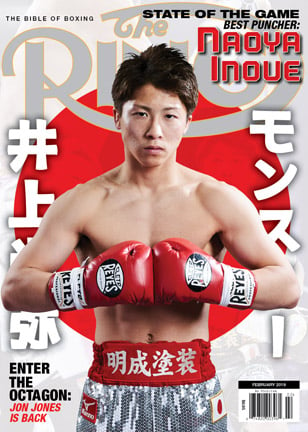The Travelin’ Man goes to Manny Pacquiao vs. Adrien Broner: Part Two
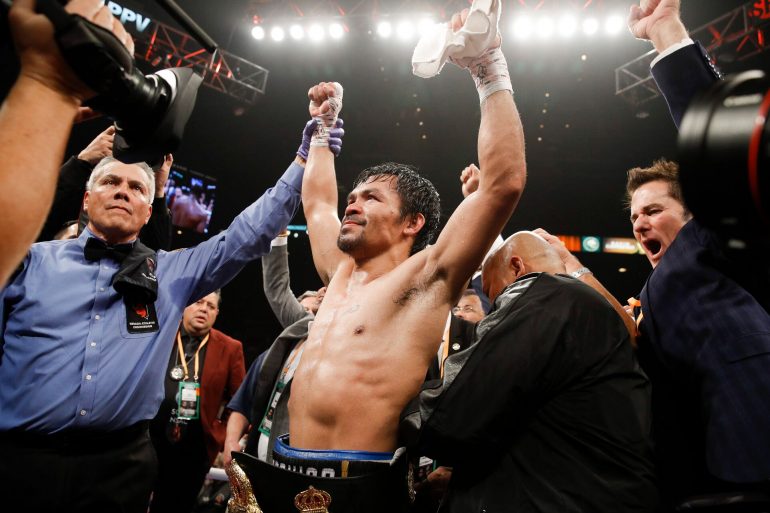
Please click here to read Part One.
Saturday, January 19 (continued): Last week in Shreveport, Louisiana, Devin Haney fought well enough to make us forget he was 20 years old. Tonight in Las Vegas, Manny Pacquiao fought well enough to make us forget he was 40 years old.
Sure, Pacquiao is no longer the force of nature that flattened Ricky Hatton with one punch, dazzled Oscar De La Hoya and David Diaz with blinding combinations and scintillating footwork or landed a mind-blowing 474 punches against a discombobulated Antonio Margarito. But can anyone name another 40-something who remains as reliant on fast-twitch speed as “The Pac-Man” and who remains able to execute his assets at a world-class level? None come to mind but one who is currently on the sideline might like to add his name to the list if the deal is right – Floyd Mayweather Jr.
If Pacquiao’s objective beyond comprehensively beating Adrien Broner was to present a viable case for a rematch with Mayweather – which remains a longshot, given the stench their first fight emitted even before it ended – then the Filipino icon did his part by solving “The Problem” in the manner he did. Against a fighter who modeled his low output/high accuracy approach on Mayweather’s, Pacquiao out-boxed him, out-foxed him and persuaded Broner to all but stop trying to win in the final two rounds. Broner’s actions – or lack thereof – in the closing rounds spoke far louder than the venomous words he spewed during the build-up. The numbers further illustrated how effectively Pacquiao picked Broner’s locks and how well he shut down the Ohioan’s attack:
* Pacquiao’s 112 total connects and 82 landed power punches more than doubled Broner’s totals in each category and Broner’s 50 total connects and 39 landed power shots are, by far, the worst numbers he ever accrued in a 12-round fight. (His previous lows were 90 total connects and 68 landed power punches against Shawn Porter.)
* Averaging just 39.9 punches per round in his previous five fights, Pacquiao averaged a healthier 47.3 against Broner and broke the 50-punch barrier three times – 66 in the third, 55 in the fifth and 69 in the seventh. Pacquiao also reached double digits in total connects five times (14 in the third, 10 in the fifth, 12 in the sixth, 19 in the seventh and 11 in the ninth). Conversely Broner averaged a meager 24.6 punches per round – the lowest average output Broner has ever recorded in 23 CompuBox-tracked fights (his previous valley was the 25.8 per round he logged against Porter) – and he was mired in single-digit connects the entire fight, with his eight connects in round four being his best).
* Pacquiao’s jab, never a fearsome weapon even in his prime, proved to be an effective dictator of distance against Broner as well as an excellent range-finder for his subsequent power shots. Pacquiao threw 371 jabs (30.9 per round) compared to just 197 power punches, meaning Pacquiao’s jab made up 65.3% of his total output, a much higher percentage than was the case in his other four post-Mayweather bouts (18.4 of 41.0 punches per round, 44.9%). Yes, he landed just 8.1% of his jabs but the punch’s pesky frequency was enough to keep Broner at bay.

Manny Pacquiao (right) vs. Adrien Broner. Photo by Esther Lin/Showtime
* Pacquiao landed 37.7% of his power punches in his five most recent bouts but against an unusually defensive-minded Broner, Pacquiao still landed 41.5% of his hooks, crosses and uppercuts, far better than the combined 32.4% rate Broner’s five most recent opponents (Jessie Vargas, Mikey Garcia, Adrian Granados, Ashley Theophane and Khabib Allakhverdiev) produced. Meanwhile Broner landed just 22% of his power punches, way below the 46.6% he landed in his five most recent fights. In fact, Broner’s 22% figure marks only the second time in 23 CompuBox-tracked fights that he fell below the 30% mark in that category (he landed 28.4% against Fernando Quintero in May 2009, a fight in which he was out-landed 154-83 overall and 125-61 power but still won a disputed eight-round majority decision). By the way, Pacquiao’s last five opponents (Mayweather, Timothy Bradley, Jessie Vargas, Jeff Horn and Lucas Matthysse) landed a combined 27.8% of their power punches, so his good showing on defense against Broner shouldn’t have been much of a surprise. Take away Mayweather’s 48.6% power accuracy and that figure falls to just 24.6%.
* Pacquiao promised before the Broner fight that he would concentrate more on body punching and he delivered in emphatic fashion. In his previous five fights, body punches accounted for just 20.1% of his total connects but against Broner, it accounted for 42% of his total connects (47 of 112) as well as 56.1% of his landed power shots (46 of 82). Broner barely recognized the concept of striking Pacquiao’s body; of his 50 total connects, only three were to the body, including just two of his 39 landed power punches.
* The numbers favoring Pacquiao might have been even wider had the Filipino kept his foot on the accelerator in the final three rounds. After landing 11 of 52 punches in the ninth, Pacquiao throttled down to 35 punches per round but still out-landed Broner 20-11 overall, 9-5 jabs and 11-6 power. This tendency to grant mercy to thoroughly beaten opponents is a staple of Pacquiao’s persona and it held true here.
* Pacquiao totally neutered a staple of Broner’s game – the second-half surge. In his five previous fights Broner averaged 39 punches per round in the first half of fights and 47 in the second half, a much gentler acceleration than was the case at 130 and 135 but an acceleration nonetheless. Here, there was an erosion; in rounds one through six against Pacquiao, Broner averaged 25 punches per round while in rounds seven through 12, he dropped to 24.2. In the final round, Broner threw just 22 punches (the same as he recorded in round one) and connected with only one punch.
* Finally, the CompuBox round-by-round breakdown of total connects per round – a useful guide since judges use clean punching as a primary determinant – Pacquiao out-landed Broner in 10 of the 12 rounds, with Broner’s edges taking place in rounds four (8-7) and 10 (7-6).
* By scoring the fight 116-112 for Pacquiao, judges Glenn Feldman and Tim Cheatham may have given Broner much the benefit of the doubt. However the fighter thought all three jurists (which included Dave Moretti and his 117-111 scorecard for Pacquiao) should have given him the fight outright.

Manny Pacquiao (left) vs. Adrien Broner. Photo by Wendell Alinea/MP Promotions
“I beat him,” a defiant Broner declared to a dumbfounded world. “Everybody out there knows I beat him. I controlled the fight. He was missing. I hit him clean more times. I beat him.”
There are many words that can be used to describe the above quote and many of them are profane. There are also many words that can be used to describe Broner’s behavior outside the ring over the years and many of them are profane. And justifiably so.
Words aside, Broner’s actions have served to burn so many bridges that we may have seen the last of him on a pay-per-view platform. The incongruency of his swaggering, street-tough pre-fight self, his safety-first approach during combat and his arrogant, spoilsport attitude in post-fight interviews is a toxic mixture that has resulted in nearly universal alienation and scorn. This group may include those decision-makers who put together the biggest fights and those who have influence on those decision-makers. The appeal of Broner’s fights has long been centered on whether the man in the opposite corner would be capable of administering the beating many buyers feel the Ohioan deserves, not on seeing an exhibition of Broner’s talents.
What a pity.
It’s a pity because, when Broner was fighting at 130 and 135, he produced a fusion of speed, talent and power that provided him the back-up for his boasts and paved the path toward pay-per-view opportunities. That Broner was worthy of occupying the pay TV stage. Unfortunately that version of Broner will be relegated to the world of videotape, DVDs and YouTube.
On a purely human level, I still hold out hope that Adrien Broner the person can find a way to alter the course of parts of his life. That said, no person is able to will another to do anything; he or she can only advise and hope the latter will accept and implement the wisdom that is imparted. Human nature being what it is, most people only welcome such input from people whom are closest to them and, to Broner, I am a total stranger. Therefore I am in no position to give him life advice and will refrain from doing so. While watching the two “All Access” shows on Showtime, it is clear Broner has a network of people on which he can rely. I do know this: As long as we are alive, we have the opportunity to affect positive change in ourselves as well as within our spheres of influence. I may be in the minority but I think Broner is as capable of achieving this as anyone else. Can it happen? Yes. Will it happen? The choice, as it is for all of us, is his – and only his – to make.
*
The gash on Badou Jack’s forehead reportedly required only 25 stitches to close but after seeing a close-up of the jagged five-inch wound on the ringside monitor, I had a hard time believing the number was that low.
The injury was started by an accidental butt in round seven and worsened by the punches Marcus Browne landed over the next five-plus rounds. The horrific gore completely obscured the fact that his conqueror-to-be had been docked a point for excessive holding in the same round that the cut was created. From that point forward, the fight’s focus was centered not only on the blood that covered Jack’s face but also why referee Tony Weeks, Jack’s corner or the ringside physicians didn’t halt the proceedings, even when the crimson obscured Jack’s sight, hampered Jack’s breathing, affected Jack’s ability to defend against Browne’s punches and failed to spark a desperation rally. It’s up to those parties to answer those questions (or not) but, life being what it is, what’s done is done and nothing can be changed.
With the wound being treated and with Jack in good spirits, this can be said in hindsight: While Jack absorbed the second defeat of his career by lopsided scores of 119-108, 117-110 and 116-111, his reputation among boxing fans received the kind of boost that can only be earned by exhibiting uncommon bravery under duress – and that boost often lasts a lifetime. The toughness, competitive drive and stubbornness to keep going amid such difficult circumstances was something to behold and, for that, he will be treated with an elevated level of respect, admiration and honor from boxing fans. Like Arturo Gatti and Micky Ward for their celebrated blood-and-guts trilogy and like Tyson Fury for getting up from Deontay Wilder’s titanic knockdown in round 12, Jack will get feedback for what he did against Browne for the rest of his life. And more often than not, that feedback will be positive. Rightly so.
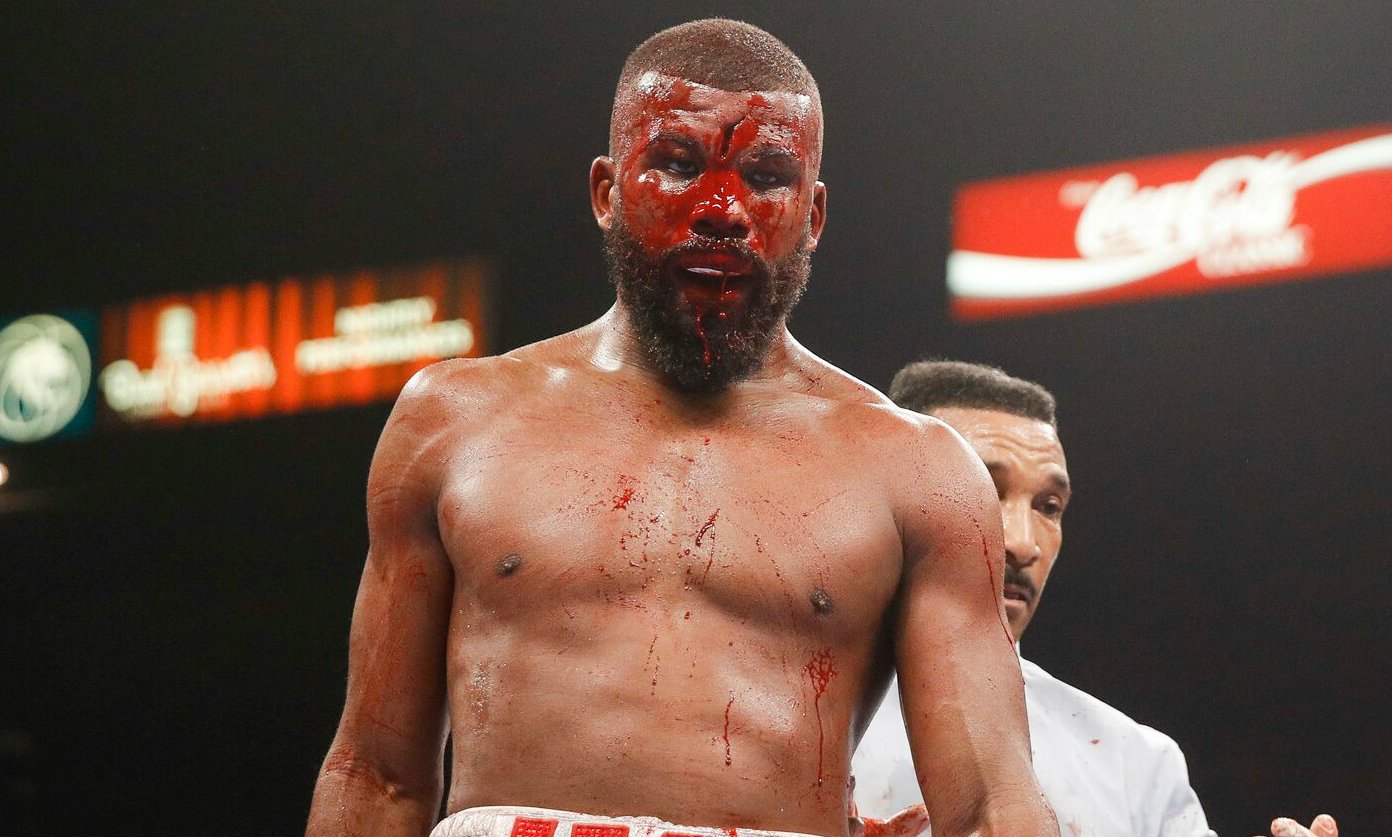
Light heavyweight contender Badou Jack. Photo credit: Esther Lin/Showtime
Speaking of feedback, the numbers were illustrative. Jack lived up to his reputation as a slow starter as he averaged 20 punch attempts in the first three rounds and allowed Browne (35.7 per round) to establish an early lead (23-13 overall, 7-1 jabs, 16-12 power). Unlike most bouts, however, Jack was never able to get out of first gear and that certainly was the case after the cut in round seven. Following a seventh round that saw Jack throw 33 punches (his second-highest total in the fight), the Swedish-born Olympian for Gambia dropped to 23 in the eighth and averaged 27 the rest of the way compared to Browne’s 48.2 in the final five rounds. In rounds eight through 12, Browne out-landed Jack 81-26 overall, 25-5 jabs and 56-21 power to expand his final leads to 145-66 overall, 42-8 jabs and 103-58 power as well as 28%-22% overall, 17%-7% jabs and 38%-31% power. The round-by-round breakdown of total connects had Browne ahead 10-1-1.
While the focus was invested on Jack, the importance of Browne’s victory shouldn’t be overlooked. This was a step-up fight for the 2012 U.S. Olympian, so much so that he was considered an underdog to the former titlist. Inside the ring, Browne (23-0, with 16 knockouts) stepped up his game and continued to do his job even after Jack’s face busted open.
An interesting post-fight sidelight: Browne urged newly-minted International Boxing Hall of Fame inductee Teddy Atlas to help arrange a fight between he and Atlas’ newly-minted WBC light heavyweight titleholder Oleksandr Gvozdyk. At age 13, Browne, a Staten Island native like Atlas, took up the sport thanks to the Atlas Cops & Kids Boxing Program.
“(It’s) the greatest thing I’ve ever done,” Browne said in a story posted on WPIX’s website in November 2014. Now, the two could be linked again but, this time, they’ll be occupying opposite corners. Say this for boxing: It will never run out of interesting stories.
*
When they met at the 2012 Olympics, America’s Rau’shee Warren was the defensive boxer, while France’s Nordine Oubaali seized the role of hard-charging aggressor. That aggressiveness helped him overcome an early deficit and capture a 19-18 decision that dropped the American’s record to 0-3 in Olympic competition.
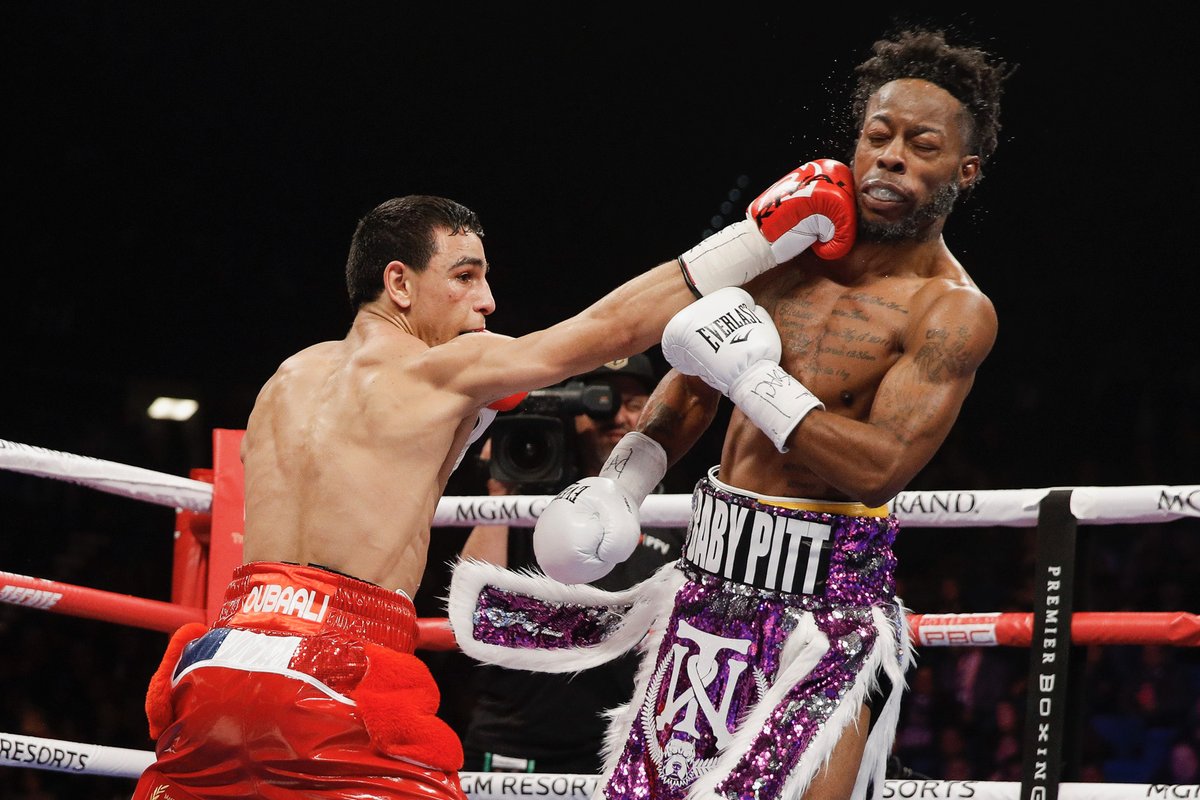
Bantamweight Nordine Oubaali (left) nails Rau’Shee Warren with a right hand. Photo credit: Showtime Boxing
Six-and-a-half years after their shared pursuit of Olympic gold (Oubaali lost in the quarterfinal to Michael Conlan), Warren and Oubaali met for the professional equivalent, in this case the vacant WBC bantamweight title. Like then, Warren was the slick counterpuncher to Oubaali’s persistent pursuer and, as was the case in London, Oubaali’s late surge ended up being the difference. In rounds eight through 12, Oubaali was busier (62.8 per round to Warren’s 48.8) and more productive as he landed twice as many punches overall (82-41), out-jabbed the jabber (16-9) and prevailed 66-32 power to extend his final margins to 156-97 overall and 126-60 power, offsetting Warren’s slim 37-30 lead in landed jabs. Oubaali also was the more accurate hitter (24%-18% overall, 17%-13% jabs, 26.2%-25.9% power) and the CompuBox round-by-round breakdown had Oubaali ahead 11-0-1 in terms of total connects, with the first six rounds separated by four or fewer connects and the final six (all favoring Oubaali) separated by eight, 11, 10, nine, two and nine. The final scores of 117-111 (Steve Weisfeld), 116-112 (Julie Lederman) and 115-113 (Ricardo Ocasio) lifted the 32-year-old Oubaali’s mark to 15-0 (with 11 KOs) and lowered the 31-year-old Warren’s to 16-3 (with 4 KOs), including 3-3 in his last six fights.
*
If any fight on the televised portion was to end in knockout, I guessed it to be the featherweight bout between Hugo Ruiz and Alberto Guevara, the latter being a late sub for the vastly overweight Jhack Tepora. That’s because Ruiz had the benefit of knowing he would be fighting on this date against a titlist (albeit a WBA “interim” one) on this date, while Guevara, who was on standby because there were whispers that Tepora would miss weight, wasn’t certain until yesterday that he would be competing. Other factors I considered: 24 of Ruiz’s 32 knockouts occurred in the first two rounds, Ruiz had trained for a 12-round fight and was now competing in a 10-rounder and Guevara, at 126, scaled the second-highest weight of his career, a deficit because he depends on mobility and durability to compensate for his modest power (12 stoppages in 31 fights).
Indeed Ruiz flashed his early power by dropping Guevara with a combination in round one but from that point forward, Guevara hung tough thanks to his defensive prowess and veteran’s savvy. He lasted the distance because he limited Ruiz to 18% overall, 6% jabs and 30% power, while connecting on 30% overall, 25% jabs and 37% power. However he lacked the energy to combine his precision with activity; he averaged just 20.7 punches per round to Ruiz’s 51.7 and thus trailed 94-62 overall and 79-33 power.
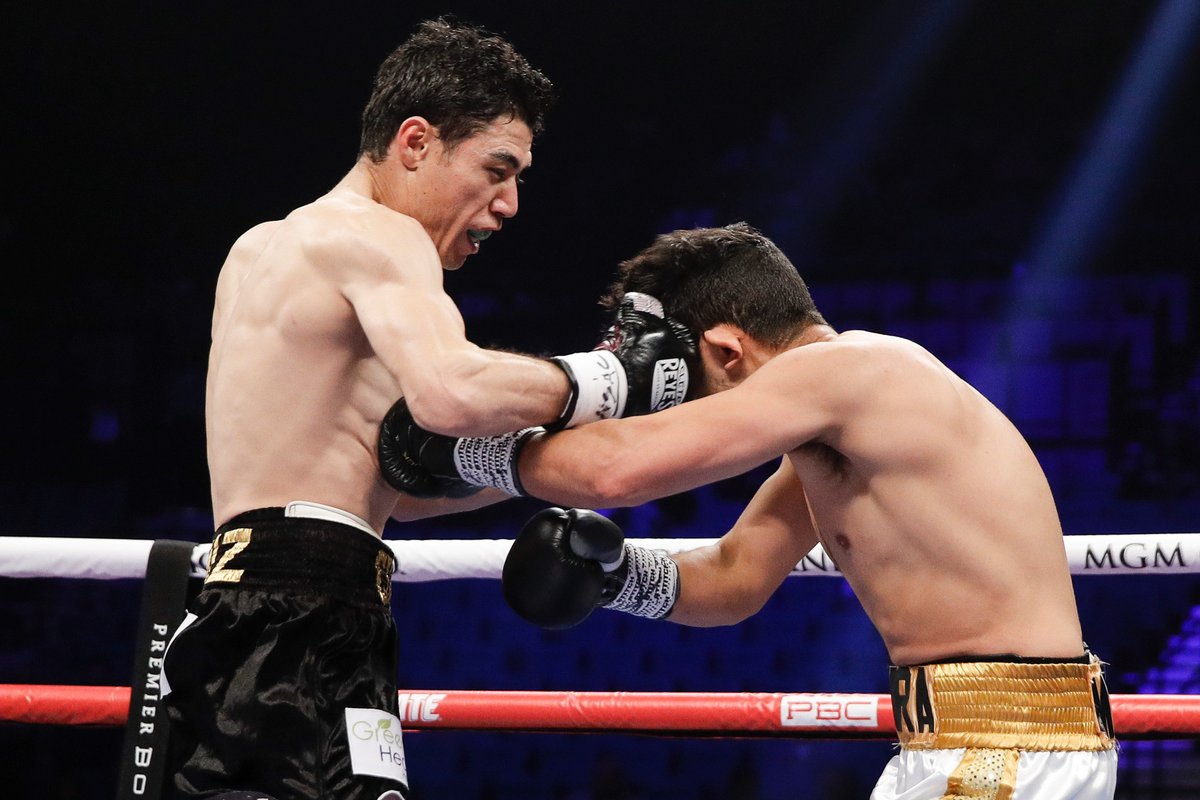
Featherweight contender Hugo Ruiz (left) catches Alberto Guevara with a right cross. Photo credit: Showtime Boxing
Ruiz was frustrated by the changes he had to face.
“I trained for the southpaw (Tepora) and then I had to fight a right-hander at the last minute,” he told RingTV’s Ryan Songalia. “The other guy was a puncher and this guy is a boxer. It made it difficult for me to fight him because it wasn’t what I trained for.”
Despite the changes, Ruiz did what he was supposed to do: Win. And Guevara did what he had to do: Survive.
*
After getting the go-ahead to shut down our laptops and to close the curtain on one of the longest fight cards we ever worked in terms of time (nearly five hours on the air), Dennis and I packed our belongings and I headed to the site of the crew meal. Instead of the usual post-card pizza, the crew dined on a variety of hoagies and chips. I don’t know about the others but, for me, it was a nice change of pace.
My appetite satisfied, I exited the arena and began the long walk to my hotel room, a walk made even longer due to the thousands clogging the walkway and the casino floor. The mass of humanity was overwhelming and, as always, the clog moved only as fast as its slowest walker.
When I reached the lobby, I checked my pockets for my room key, and, to my surprise, it was not there. No problem. Thanks to a helpful hotel employee – and to the fact I had my room number memorized and my identification at the ready – I got a new set of keys and was able to re-enter the room.
The good thing about fights that don’t have a huge number of punches is they require less time to add to the database. That was the case for each of the five fights Dennis and I counted here. Yes, all the bouts went the distance – 54 rounds in all – but the process took just over an hour to complete.
With a goal wake-up time of 5 a.m., I turned out the light shortly after 1 a.m. local time.
Sunday, January 20: I stirred awake a few times – ended dreams tend to do that – and happily after the final one, I glanced at my phone (the room had no clock) and saw it was 4:55 a.m.
Perfect.
After completing the morning routines, I spent a few minutes on the laptop, finished packing, checked out of the hotel and took a taxi to the airport. Even better: I had a direct flight back to Pittsburgh and, if all went well, I would touch down around 3:30 p.m. EST, start the drive home by 4 and be home between 6:30 and 7, depending on the weather.
Except not all went as planned. The plane that was to take us to Pittsburgh had to be used to fly another route and the time needed to provide us a replacement aircraft pushed back our departure by 45 minutes. Also my Southwest boarding pass bore the designation C-30 – meaning I would be the 30th to last person to enter the plane. Worse yet: I couldn’t get a Business Select upgrade. Therefore I was resigned to the possibility that I would be in a middle seat for a four-hour flight.
As I waited for my group to begin boarding, I chatted with an older Pittsburgh sports fan who had attended the previous evening’s hockey game between the Penguins and the Las Vegas Golden Knights (the Pens lost 7-3 before 18,511 patrons, the second-largest crowd in the Knights’ two-year history). When I boarded the plane, I was pleasantly surprised to see that fan and his wife in row 22 – and they occupied the window and middle seats. I asked if I could sit with them in the remaining aisle seat and the man, figuring me to be a good egg based on our previous conversation, said yes.
So much for my middle-seat worries.
I had planned to get some needed shuteye on this flight but, me being me, I spent the entire flight chatting with people seated in close proximity. However my conversation wasn’t with the man seated with his wife but with the woman seated across from me on the other side of the aisle, a former flight attendant accompanied by her teenage daughter and her husband. We told our life stories, swapped tales of previous travels and talked about what we did while in Vegas.
At one point, a man seated a couple of rows behind us approached me. He had overheard my remarks about the Pacquiao fight – a fight which he had attended – and began peppering me with a series of boxing-related questions. I was all too happy to oblige, and when we finished a few minutes later he gave me his business card, which revealed he worked for a Pittsburgh wholesale company. I fished for mine but discovered I had exhausted my current supply.
The plane touched down shortly after 3:30 p.m. EST and the dramatic difference in temperature between Vegas and Pittsburgh became crystal clear the moment we stepped onto the jetway. At the first opportunity, I dug into my clothes bag and put on a heavy sweater but it wouldn’t be enough to completely neutralize the effects of a 15-degree air temperature and a breeze strong enough to make my eyes water.
Even worse: The driver’s side of my vehicle was caked in half-inch thick ice. I scraped away what I could while hoping the car’s heater would take care of the rest. After 28 minutes of on-and-off scraping, I managed to clear away just enough of the ice on the driver’s side window to see my mirrors but I couldn’t get my power windows to budge. That made the process of paying the parking bill a bit awkward – I had to step out of the car to pay the man inside the booth – but, once I did, I was on my way.
The power window remained jammed even after the ice had melted away and I called home a few times to keep tabs on the state of my driveway. When I came within sight of it, I saw it had a light layer of snow in areas but it wasn’t nearly as thick as it had been the previous weekend. Still, I got a much better run on it and though I felt a little slide about a third of the way up, I was able to power my way to the top.
With that, my latest Travelin’ Man journey ended. However, my battles with Old Man Winter (and his cohorts Jack Frost and Mr. Freeze) will continue in less than two weeks’ time and, this time, I won’t be able to steer clear of him – or any of them. The reason: The “ShoBox” tripleheader topped by Ronald Ellis vs. DeAndre Ware will take place at the Main Street Armory – in Rochester, New York.
Until then, happy trails!
*
Lee Groves is a boxing writer and historian based in Friendly, West Virginia. He is a full member of the BWAA, from which he has won 16 writing awards, including two first-place awards, since 2011. He has been an elector for the International Boxing Hall of Fame since 2001 and is also a writer, researcher and punch-counter for CompuBox, Inc. He is the author of “Tales from the Vault: A Celebration of 100 Boxing Closet Classics” (available on Amazon) and the co-author of the newly released book “Muhammad Ali: By the Numbers” (also available on Amazon). To contact Groves about a personalized autographed copy, use the email [email protected] or send him a message via Facebook.
Struggling to locate a copy of The Ring Magazine? Try here or
Subscribe
You can order the current issue, which is on newsstands, or back issues from our subscribe page.



